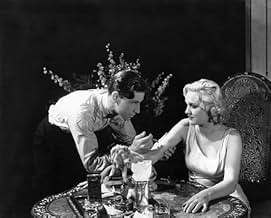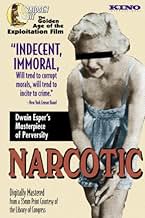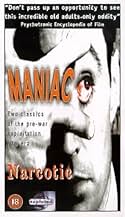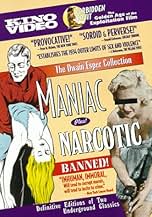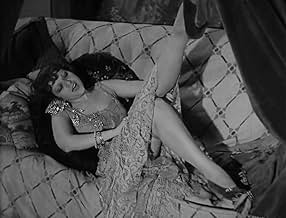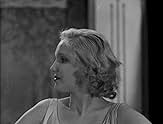अपनी भाषा में प्लॉट जोड़ेंThis exploitation film follows the downward spiral of an idealistic medical student whose fall from grace leads him to opium dens, a carnival freakshow, swanky drug parties, dingy brothels, ... सभी पढ़ेंThis exploitation film follows the downward spiral of an idealistic medical student whose fall from grace leads him to opium dens, a carnival freakshow, swanky drug parties, dingy brothels, and finally the barrel of his own revolver.This exploitation film follows the downward spiral of an idealistic medical student whose fall from grace leads him to opium dens, a carnival freakshow, swanky drug parties, dingy brothels, and finally the barrel of his own revolver.
Herman Hack
- Burger
- (बिना क्रेडिट के)
Celia McCann
- Prostitute
- (बिना क्रेडिट के)
Elmer McCurdy
- Self
- (बिना क्रेडिट के)
Fred Parker
- Policeman
- (बिना क्रेडिट के)
Philip Sleeman
- Drug Addict
- (बिना क्रेडिट के)
Hildegarde Stadie
- Blonde Waiting Outside Davies' Office
- (बिना क्रेडिट के)
Blackie Whiteford
- Dennison
- (बिना क्रेडिट के)
फ़ीचर्ड समीक्षाएं
This is a movie that I found when looking for horror from 1933. The title intrigued me as I didn't know if we would be getting like an early drug dealing movie or what. I came into this one blind aside from knowing the year and that it was in genre. I did notice Harry Cording starred, which I just saw him in another movie from the same year as well.
Synopsis: exploration film which follows the downward spiral of an idealistic medical student whose fall from grace leads him to opium dens, a carnival freakshow, swanky drug parties, dingy brothels and finally a realization of his decisions.
Now I'll admit, I did clean up the synopsis a bit as it spoiled the ending. This is an early propaganda film to prevent drug addiction. It warns us with opening text that the medical student from the synopsis becomes a successful snake oil salesman. His name is Dr. William G. Davis (Cording). This is also supposedly based in fact. Upon watching it, I'm sure there are plot points here that mirror real people or things that did happen.
We see William when he is still a med student. He hangs out with a few guys and one is Gee Wu (J. Stuart Blackton Jr.). This is a racist take on someone from Asian and he introduces William to an opium den. What I find interesting here is that we get a look at American and western culture. Gee states that in Asia, they're able to use opium recreationally and not become fully addicted. There are those that do, but for the most part they can use it as a release. In America, they get hooked and this is warning the viewer to stay away from these dens. Also that Americans push to the excess more easily.
It is from here that William becomes addicted. He doesn't think he is and that he can stop whenever. There is a vibe here of 'The Strange Case of Dr. Jekyll and Mr. Hyde' with William working in a free clinic. He doesn't make a lot of money though. He is striving to buy a gold locket but can't afford it. He gets the idea to use opium to create a tonic and watching a peddler makes him realize he needs to find the right way to market it. This isn't far from the truth before regulations prevented putting things like this freely in items.
Without going through each of the points from the synopsis again, William is hurt in a car accident and that gets him hooked back on opium. The driver that crashes with him in the vehicle is also an addict. William lives an interesting life with a circus and scores dope with a guy there. He also hangs out with the likes of Lena (Jean Lacy), Mae (Patricia Farley) and her friends as they use different things as well. It also shows us the effects of living life this way.
That is where I'll leave my recap and introduction to the story. Where I want to start is the tone here. This is absolutely a propaganda film a la Reefer Madness. What I'll give credit here is that I've seen the effects heroin has on people so this is much closer. I didn't bring up that there is a couple more texts screens that we get, one stating that the drug party we see is something that most don't get to. We are able to due to people getting clean and relaying what they experienced. I bring this up as they're using heroin, pills and smoking 'marijuana cigarettes'. This goes heavy handed with its message. At least it is closer to form though.
With that set up, let me get into whether this is horror or not. It isn't in the traditional sense. We don't get murders or monsters or anything to this effect. What we do though is see is more the horrors of humanity and our decisions. The 'horror' is drug addiction here. What is interesting is that this movie portrays it as fun. That is until the 'bill comes due' and you must pay. What I'll say is that it doesn't end well for William. Do not come into this expecting horror as we know it today. This is a cautionary tale.
There isn't more to go into the story for me so I'll go to the acting. This isn't good either. It is stiff. I'm not going to go through each person to see if they acted after or even before this. I do think that Cording is fine as our lead. We see him go through a lot of things and that works. Other than that, Joan Dix, Farley, Lacy and the rest of the cast are fine. It can be stiff and I don't know if this does the best at conveying the effects of what they're doing. The gravity is there, but it comes off comical to me. I did want to give credit to Blackton. It is racist to have him playing this character. I do like what they gave him to work with though. This is a western way of looking at things though as well.
All that is left then would be the filmmaking. I don't think this is particularly strong either. The cinematography is fine. The different set pieces we see are good. It is an interesting path that William goes along. The message is too heavy handed though to the point were watching it today made me laugh. We don't get a lot in the way of effects, but this feels more like a docu-drama than a movie so that is part of it. The soundtrack also didn't stand out or hurt this either.
In conclusion, this isn't a good movie. I think there is a good message this wants to convey, but it doesn't translate as well for modern viewers. It might have been for the 1930s. The acting is stiff. Cording and Blackton being the two best performances despite my issue with the casting of the latter. The filmmaking is fine. It is lacking there. This also isn't horror in the traditional sense either. It is more of a cautionary tale for sure. I can't recommend this unless you want to laugh at what this tries to do.
My Rating: 4.5 out of 10.
Synopsis: exploration film which follows the downward spiral of an idealistic medical student whose fall from grace leads him to opium dens, a carnival freakshow, swanky drug parties, dingy brothels and finally a realization of his decisions.
Now I'll admit, I did clean up the synopsis a bit as it spoiled the ending. This is an early propaganda film to prevent drug addiction. It warns us with opening text that the medical student from the synopsis becomes a successful snake oil salesman. His name is Dr. William G. Davis (Cording). This is also supposedly based in fact. Upon watching it, I'm sure there are plot points here that mirror real people or things that did happen.
We see William when he is still a med student. He hangs out with a few guys and one is Gee Wu (J. Stuart Blackton Jr.). This is a racist take on someone from Asian and he introduces William to an opium den. What I find interesting here is that we get a look at American and western culture. Gee states that in Asia, they're able to use opium recreationally and not become fully addicted. There are those that do, but for the most part they can use it as a release. In America, they get hooked and this is warning the viewer to stay away from these dens. Also that Americans push to the excess more easily.
It is from here that William becomes addicted. He doesn't think he is and that he can stop whenever. There is a vibe here of 'The Strange Case of Dr. Jekyll and Mr. Hyde' with William working in a free clinic. He doesn't make a lot of money though. He is striving to buy a gold locket but can't afford it. He gets the idea to use opium to create a tonic and watching a peddler makes him realize he needs to find the right way to market it. This isn't far from the truth before regulations prevented putting things like this freely in items.
Without going through each of the points from the synopsis again, William is hurt in a car accident and that gets him hooked back on opium. The driver that crashes with him in the vehicle is also an addict. William lives an interesting life with a circus and scores dope with a guy there. He also hangs out with the likes of Lena (Jean Lacy), Mae (Patricia Farley) and her friends as they use different things as well. It also shows us the effects of living life this way.
That is where I'll leave my recap and introduction to the story. Where I want to start is the tone here. This is absolutely a propaganda film a la Reefer Madness. What I'll give credit here is that I've seen the effects heroin has on people so this is much closer. I didn't bring up that there is a couple more texts screens that we get, one stating that the drug party we see is something that most don't get to. We are able to due to people getting clean and relaying what they experienced. I bring this up as they're using heroin, pills and smoking 'marijuana cigarettes'. This goes heavy handed with its message. At least it is closer to form though.
With that set up, let me get into whether this is horror or not. It isn't in the traditional sense. We don't get murders or monsters or anything to this effect. What we do though is see is more the horrors of humanity and our decisions. The 'horror' is drug addiction here. What is interesting is that this movie portrays it as fun. That is until the 'bill comes due' and you must pay. What I'll say is that it doesn't end well for William. Do not come into this expecting horror as we know it today. This is a cautionary tale.
There isn't more to go into the story for me so I'll go to the acting. This isn't good either. It is stiff. I'm not going to go through each person to see if they acted after or even before this. I do think that Cording is fine as our lead. We see him go through a lot of things and that works. Other than that, Joan Dix, Farley, Lacy and the rest of the cast are fine. It can be stiff and I don't know if this does the best at conveying the effects of what they're doing. The gravity is there, but it comes off comical to me. I did want to give credit to Blackton. It is racist to have him playing this character. I do like what they gave him to work with though. This is a western way of looking at things though as well.
All that is left then would be the filmmaking. I don't think this is particularly strong either. The cinematography is fine. The different set pieces we see are good. It is an interesting path that William goes along. The message is too heavy handed though to the point were watching it today made me laugh. We don't get a lot in the way of effects, but this feels more like a docu-drama than a movie so that is part of it. The soundtrack also didn't stand out or hurt this either.
In conclusion, this isn't a good movie. I think there is a good message this wants to convey, but it doesn't translate as well for modern viewers. It might have been for the 1930s. The acting is stiff. Cording and Blackton being the two best performances despite my issue with the casting of the latter. The filmmaking is fine. It is lacking there. This also isn't horror in the traditional sense either. It is more of a cautionary tale for sure. I can't recommend this unless you want to laugh at what this tries to do.
My Rating: 4.5 out of 10.
Someone who only knows of Esper, coming to this film with n open mind will I think be rather surprised at how good it is. Far from being a mindless hack who churned out any oddly rubbish for the so-called "exploitation" market, Esper very clearly had aspirations of an artistic kind and experiments with European-style montage (not simply "irrelevant footage" as one reviewer seems to think), very rare in US film, and with some interesting chiaroscuro effects. This sometimes makes the continuity a little dodgy but gives the film a certain quality much superior to the general run of "Poverty Row" films.
By contrast, his follow-up, Maniac, which dabbles in horror/melodrama somewhat in the line of the contemporary British star Tod Slaughter, is not nearly so good a film and gives a yardstick by which to appreciate the real qualities of Narcotic.
What one also sees most clearly with Esper at his best is the way in which the "exploitation" film is really a sort of alter ego, a shameful double of the US industry as a whole. Consider for instance how a typical police-operation gangster film uses essentially the same tropes - one part of the film follows the police or the FBI (emphasising the evil of the gangsterism in narrations that are not unlike Esper's supposedly didactic intertitles, while the other part of the film allows the viewer to enjoy the antics of the gangster.
Genre after genre in US cinema in fact exhibit the same essential traits as the "exploitation" film because it is what, between censorship rules and greed for high profits, the US film industry had essentially learned to be and Esper's films are simply a microcosm, Hollywood denuded of its glamour.
Note two how this film is interestingly rooted in the memory of Hollywood with silent stars Paul Panzer and Josef Swickard and even the son of film pioneer Stuart Blackton amongst the cast.
By contrast, his follow-up, Maniac, which dabbles in horror/melodrama somewhat in the line of the contemporary British star Tod Slaughter, is not nearly so good a film and gives a yardstick by which to appreciate the real qualities of Narcotic.
What one also sees most clearly with Esper at his best is the way in which the "exploitation" film is really a sort of alter ego, a shameful double of the US industry as a whole. Consider for instance how a typical police-operation gangster film uses essentially the same tropes - one part of the film follows the police or the FBI (emphasising the evil of the gangsterism in narrations that are not unlike Esper's supposedly didactic intertitles, while the other part of the film allows the viewer to enjoy the antics of the gangster.
Genre after genre in US cinema in fact exhibit the same essential traits as the "exploitation" film because it is what, between censorship rules and greed for high profits, the US film industry had essentially learned to be and Esper's films are simply a microcosm, Hollywood denuded of its glamour.
Note two how this film is interestingly rooted in the memory of Hollywood with silent stars Paul Panzer and Josef Swickard and even the son of film pioneer Stuart Blackton amongst the cast.
Another "message" film by Dwain Esper, also written by his wife, Hildegarde Stadie, as was Maniac. It is an example of pre-code Hollywood, and has a place in film history. The message, is, of course, about the evils of drugs.
It is interesting that the Asian in the film was play by a Caucasian, none other than J. Stuart Blackton Jr., who, along with D.W. Griffith, was a pioneer in the development of the motion picture art.
The film also features Jean Lacy, who as Jeanne Gray, had her own talk show on TV from 1949-51. She didn't like the way the young announcer introduced her, "And Nowww, Thhhe . . . Jeeeeannne . . . Graaaay . . . " Thayoung announcer, who wanted his own show, was none other than Johnny Carson.
At least it wasn't as silly as Reefer Madness.
It is interesting that the Asian in the film was play by a Caucasian, none other than J. Stuart Blackton Jr., who, along with D.W. Griffith, was a pioneer in the development of the motion picture art.
The film also features Jean Lacy, who as Jeanne Gray, had her own talk show on TV from 1949-51. She didn't like the way the young announcer introduced her, "And Nowww, Thhhe . . . Jeeeeannne . . . Graaaay . . . " Thayoung announcer, who wanted his own show, was none other than Johnny Carson.
At least it wasn't as silly as Reefer Madness.
From the obviously Caucasian 'Chinaman' who introduces opium to the protagonist, to the patently absurd narcotics party scene, this film makes little attempt at realism, belying its claim that it accurately depicts the scourge of heroin addiction. Disguised as a public service type of message, it instead seeks to titillate the viewer, and is in this sense exploitive, prurient for its day, and intellectually dishonest.
Nice background music, though, including passages from Wagner's Gatterdammerung and Schubert's Unfinished Symphony.
Nice background music, though, including passages from Wagner's Gatterdammerung and Schubert's Unfinished Symphony.
Although this movie is supposedly based on actual events, the production values of the film betray that it is yet another old exploitation film--the sort that were produced by fly-by-night production companies to prey upon the public's fear AND fascination with sex and drugs. But, since such topics could not generally get past the censor boards of each state, they were marketed as "educational" and shown to adults-only audiences. Some of the obvious problems with the film are the use of silent film footage (when shown on a normal projector, it runs too fast and looks odd), clips of a baby being delivered by c-section (for little apparent reason other than they happened to have the film and decided to shove it into the movie) as well as choppy editing and poor acting. It's obvious th was NOT a large budget production, but made 'on the cheap', so to speak.
After showing a lot of seemingly irrelevant stock footage, the story begins. A Chinese man who looks about as Chinese as Eddie Murphy is talking with a couple American men. Later, one of them approaches this 'Asian' and requests that they do some opium together. So, they go to an opium den and hit the pipe. While this is pretty cheesy since the Chinese guy obviously ISN'T, the way they demonstrate opium and the paraphernalia is surprisingly accurate compared to the information you usually get in such films. Soon you see the two drift into a blissful stupor. Later, the American guy goes back for more and he's obviously hooked. How this turns him into a man who sells patent medicines is beyond me.
The rest of the film is jam-packed full irrelevant film footage--including odd clips of sideshow freaks, speeding cars and, cats staring at snakes--once again, whatever they seemed to have on hand--slapping it all together and hoping to make a semi-coherent film. And, unlike the segment on opium, the drug information is, to put it charitably, histrionic! Supposedly wild parties and a guy ripping the dress off his wife when he ran out of drugs are among the more outlandish scenes in this film--that, by this point, has become an almost plot less mess. By then end, the opium addict is a complete and total mess and he begins quoting Bible verses about the danger of alcohol--as he calls out to God and then kills himself. Believe it or not, this scene actually is well done--with some dandy acting by the addict. But, sadly, it's about the only well made portion of the film! Some of the problems with the film were probably not originally in the film. Many times, the film appears to have little bits and pieces missing and as a result, the film is pretty choppy. Considering this was a Kino DVD, I assume this is simply the best copy they have as this company usually does a good job in producing excellent quality disks.
It's obvious from my review that this is a terrible film. But, is it worth seeing--after all, some bad films are so stupid and clumsily made that they are fun to see and laugh at--especially with friends. Well, this film is stupid and you will laugh a bit at its horribleness--but it never quite reaches the same level of histrionics and stupidity of such cult classic bad films as "Reefer Madness". Still, it's good for a laugh or two and probably did little to educate anyone--especially with such lines as "Ladies, ladies...let's not get vulgar...YET!".
After showing a lot of seemingly irrelevant stock footage, the story begins. A Chinese man who looks about as Chinese as Eddie Murphy is talking with a couple American men. Later, one of them approaches this 'Asian' and requests that they do some opium together. So, they go to an opium den and hit the pipe. While this is pretty cheesy since the Chinese guy obviously ISN'T, the way they demonstrate opium and the paraphernalia is surprisingly accurate compared to the information you usually get in such films. Soon you see the two drift into a blissful stupor. Later, the American guy goes back for more and he's obviously hooked. How this turns him into a man who sells patent medicines is beyond me.
The rest of the film is jam-packed full irrelevant film footage--including odd clips of sideshow freaks, speeding cars and, cats staring at snakes--once again, whatever they seemed to have on hand--slapping it all together and hoping to make a semi-coherent film. And, unlike the segment on opium, the drug information is, to put it charitably, histrionic! Supposedly wild parties and a guy ripping the dress off his wife when he ran out of drugs are among the more outlandish scenes in this film--that, by this point, has become an almost plot less mess. By then end, the opium addict is a complete and total mess and he begins quoting Bible verses about the danger of alcohol--as he calls out to God and then kills himself. Believe it or not, this scene actually is well done--with some dandy acting by the addict. But, sadly, it's about the only well made portion of the film! Some of the problems with the film were probably not originally in the film. Many times, the film appears to have little bits and pieces missing and as a result, the film is pretty choppy. Considering this was a Kino DVD, I assume this is simply the best copy they have as this company usually does a good job in producing excellent quality disks.
It's obvious from my review that this is a terrible film. But, is it worth seeing--after all, some bad films are so stupid and clumsily made that they are fun to see and laugh at--especially with friends. Well, this film is stupid and you will laugh a bit at its horribleness--but it never quite reaches the same level of histrionics and stupidity of such cult classic bad films as "Reefer Madness". Still, it's good for a laugh or two and probably did little to educate anyone--especially with such lines as "Ladies, ladies...let's not get vulgar...YET!".
क्या आपको पता है
- ट्रिवियाThe film includes an appearance of Elmer McCurdy, an Oklahoma would-be bank robber who was killed in 1911, and whose embalmed body circulated through various sideshows, fun houses and amusement parks for over 60 years. McCurdy's body was not only used as that of a "drug addict" in the film but was put on display by Dwain Esper at screenings of the movie. McCurdy was eventually discovered in a Long Beach (CA) funhouse in 1977 by a film crew for the TV series The Six Million Dollar Man (1974) and he was returned to Oklahoma for proper burial.
- गूफ़When Davies is persuading his wife that his plan will work, the boom shadow falls the wall behind them. Also, the mike dips briefly into the shot and, and the camera moves forward, the shadow of the accordion-style apparatus used to hoist the mike is also visible, almost distractingly so, on the wall, right behind the wife.
- कनेक्शनFeatured in Narcotic Dens of the Orient (1953)
टॉप पसंद
रेटिंग देने के लिए साइन-इन करें और वैयक्तिकृत सुझावों के लिए वॉचलिस्ट करें
विवरण
बॉक्स ऑफ़िस
- बजट
- $8,900(अनुमानित)
- चलने की अवधि57 मिनट
- रंग
- ध्वनि मिश्रण
- पक्ष अनुपात
- 1.37 : 1
इस पेज में योगदान दें
किसी बदलाव का सुझाव दें या अनुपलब्ध कॉन्टेंट जोड़ें


